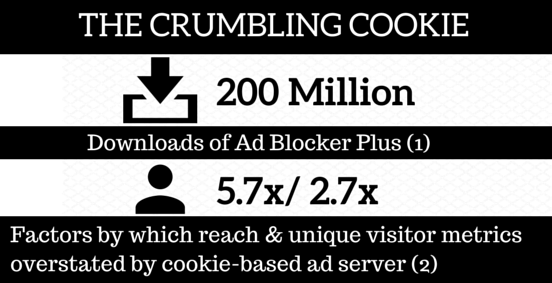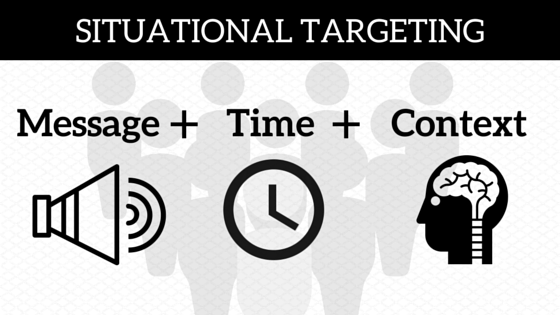Reaching the Invisible Audience: Low Information Profiles
Posted by on July 8, 2015 Marketing, Data Analytics
It’s getting harder to identify and convert prospects with traditional targeting methods. Dark pools of low information web browsers are now navigating under the radar and out of reach of advertisers. In some cases, digital advertising industry estimates suggest, audience reach has been cut in half.

Sources: (1) Forrester (2) Comscore
What’s happening?
The cookie has served as the key for digital marketers looking to serve relevant messages in brand-safe environments. This is even more true as the industry transitions to programmatic advertising and real time bidding (RTB) that deliver a revolution in pricing efficiency, scale, and reach.
But the automation and algorithms powering today’s programmatic platforms are only as good as their inputs. And the reach of these platforms is eroding rapidly as the size of the invisible audience grows.
The Crumbling Cookie
The cookie’s not dead yet, but its effectiveness is dissipating.
While cookies have been effective in targeting and retargeting specific audiences, they are increasingly being rejected by browsers and mobile technology. Meanwhile, cookies are under fire for privacy concerns.
The issue of privacy has spawned cookie blocking tools such as those provided by Ghostery and IP address wiping features like that provided by Disconnect, a do not track movement, and an increased number of users who don’t accept cookies.
This is the invisible audience.

Sources: (1) Mozilla (2) Comscore
With browsers either no longer supporting or reacting inconsistently to some third party cookies-the segments marketers routinely buy to complement their own first party data-advertisers are finding it more difficult to target prospects who are spending more time on mobile devices where cookies are not working as expected.
Additionally, large publishers under pressure from their users and in some cases regulators, are expected to experiment or transition altogether to cookie free tracking technology in the near future.
This would likely lead to greater audience fragmentation, require marketers to strike individual advertising agreements with publishers, and result in a loss of scale.
It means the invisible audience that’s currently growing would become even larger.
The dark pools forming because they are overlooked by or hiding from cookie tracking technology will become even darker and harder to reach.
Seeing the Invisible
Campaign reach may be extended despite cookie barriers and the shift to mobile by using precision targeting techniques that allow marketers to illuminate dark pools of prospects and consumers.
Situational targeting is evolving and attempting to do just this by serving the right message, to the right audience, in the right context despite cookie limitations and low information profiles.

Situational targeting does not rely on cookies to identify target audiences.
Instead, it uses real time data to create dynamic marketing messaging based on signals generated by devices and applications users themselves have enabled.
Situational targeting leverages the times, places, and situations when and where prospects and customers are most apt to respond to a specific advertising message.
The information gleaned from specific devices and applications may be used in combination with other criteria important to a marketer to serve ads that solve specific problems for users who might previously go unnoticed.
How Situational Targeting Works
Besides identifying the times and places consumers make purchasing decisions, situational targeting serves ads that are often perceived by customers as solutions rather than marketing intrusions.
Not only can cookie free precision targeting extend campaign reach but it may also also reduce the impressions marketers need to increase conversions.
However, situational targeting isn’t just about CTR optimization.
It’s the difference between a click-focused campaign and true engagement.
Rather than relying on cookie tracking technology, marketers interested in tapping unseen audiences are using data that recognizes a user’s device and core signals being generated by the device to serve highly relevant ads at precisely the right moment.
It’s as if an advertiser is fingerprinting a device or its applications to create unique user profiles.
What types of situational data are being combined to unearth and target once unseen audiences?
Situational targeting uses data such as:
-
Location, geography, & proximity
-
Weather
-
Time
-
Technology
-
Mobile relevancy
The data may be used in tandem with algorithms constructed from similar user profiles or patterns of behavior indicative of users who have already made similar purchasing decisions.
Or situational data like location, which users voluntarily provide, may be combined with audience data to create even richer profiles and reach users across screens and in largely mobile environments.
Situational targeting solves specific problems based on data that paint a picture of the environment or situation a consumer is in.
Situational data positions a marketer to serve dynamic rather than static creative in real time to improve conversion rates.
Situational Targeting in the Real World
Hyper-relevant messaging dictated by time-sensitive situational cues is helping Walmart improve CTRs.
The retailer recently used location data to target ads based on consumers’ proximity to various local landmarks.
For instance, a consumer near a park might see an ad that reads, “Going Camping? Get your gear at…”
If a consumer were near a pool the ad might read, “Make a splash! Save on swimwear at….”
Location based targeting like this resulted in a 35% lift in Walmart’s CTR’s vs the industry average.

Source: Telmetrics-xAd 2012
However, situational targeting also offers opportunities to combine cues for even better results.
When Walmart incorporated environmental cues such as weather, the company was able to serve ads to people near parks on a hot summer day that read, “Get your grill on. Stock up at….”
Likewise, Walmart was also able to use situational targeting to adjust its message based on the time of day ads were shown.
For instance, prospects located in business areas who were likely preparing to leave the office around 4 P.M. were shown an ad that read, “Going Home? Get what you need at….”
The results, after combining time, place, and environmental cues, reveal Walmart’s use of situational targeting improved CTRs 52%-106% versus the industry average during specific time periods.
Conclusion
Situational targeting won’t deliver the pin-point targeting of cookie-based targeting, but it improves the performance of ads delivered to the invisible audience. It also positions today’s marketer to adapt to the shift to mobile and multi-screen browsing and away from cookie tracking technology.
Not only does situational data allow marketers to identify and target audiences often invisible to cookie-dominant platforms, but it also allows advertisers to significantly extend campaign reach while reducing the number of impressions required to optimize conversions.
The ability to adjust marketing messages in real time and based on data allow marketers to reposition themselves as problem solvers and providers of solutions rather than messaging intruders or interrupters.
The results are improved CTRs, engagement, and appreciative consumers who perceive the marketer as a valued partner in the problem solving process.


